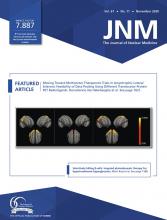TO THE EDITOR: For efficiently differentiating the pancreas uptake of the dopamine D2/D3-receptor agonist 11C-(+)-PHNO (3,4,4a,5,6,10b-hexahydro-2H-naphtho[1,2-b][1,4]oxazin-9-ol) between healthy controls and patients with type 1 diabetes mellitus (T1DMs), Bini et al. recently compared different methods of quantitative PET imaging. These methods involved tissue-compartment model analyses providing the tracer distribution volume, as well as reference-region approaches, which did and did not require arterial sampling, respectively (1). Quantitative parameters were also correlated to clinically relevant measures of β-cell-mass function such as C-peptide, proinsulin, age at diagnosis, and disease duration. The authors reported a reduction in the 20- to 30-min pancreas-to-spleen SUV ratio of 36.2% between healthy controls and T1DMs (P = 0.03) and concluded that this ratio could be used to differentiate β-cell mass in healthy controls and T1DMs.
We assume that the study of Bini et al. did not fully take into account the trapping reversibility of 11C-(+)-PHNO in the pancreas of both healthy controls and T1DMs—a characteristic that could, in addition, be helpful for assessing β-cell mass using data acquired beyond 30 min after injection. Trapping reversibility is evidenced in Figure 3 of the paper, in which representative decay-corrected time–activity curves of the pancreas (and spleen) acquired over 120 min clearly do not reach a plateau at late imaging (1,2).
First, let us note that trapping reversibility may impair the use of distribution volume, that is, the equilibrium ratio of tissue concentration to plasma concentration, when this ratio is assessed at any time after injection, unlike under irreversible trapping condition (3).
Second, Bini et al. acknowledged that the 1-tissue-compartment model does not fit the data for times of more than 60 min (Fig. 3) (1). In this connection, we have recently indicated that a previously published method can then be applied to any tracer for assessing its release rate constant from tissue back to blood at late imaging, that is, when the part of free tracer in blood and interstitial volume plus, possibly, the part of radiolabeled metabolites have become negligible in the tissue time–activity curve (4). Comparison between arterial input function and pancreas SUV (Figs. 1 and 3, respectively) shows that this part is less than 2% at 30 min after injection, thus allowing the fitting of the pancreas (decay-corrected) time–activity curve beyond 30 min after injection with a monoexponentially decaying function (GraphPad Prism software, version 5.00), writing y = 37.54×exp(−0.02621×t), where 0.02621 min−1 (SD = 0.00055) is the release rate constant estimate for 11C-(+)-PHNO release from pancreas back to blood (amplitude SD = 1.14; R = 0.998; data extracted with the WebPlotDigitizer software). We therefore suggest that the amplitude and release rate constant obtained from the pancreas time–activity curve monoexponential fitting beyond 30 min after injection could be helpful to differentiate β-cell mass in healthy controls and T1DMs.
To conclude, Bini et al. relevantly emphasized the potential utility of 11C-(+)-PHNO for measuring the β-cell mass in vivo in T1DMs and, hence, the need for a reliable PET quantitative method to assess disease progression and efficacy of therapies, in combination with functional measures. We suggest that the significant reversibility of 11C-(+)-PHNO trapping in the pancreas has not been fully exploited. Indeed, without the need for arterial sampling, monoexponential fitting of the pancreas time–activity curve beyond 30 min after injection might be a relevant quantitative method to further differentiate β-cell mass in healthy controls and T1DMs. Finally, we suggest that investigating the possible correlation of the derived amplitude and release rate constant with C-peptide, proinsulin, age at diagnosis, and disease duration might be of interest.
Footnotes
Published online Jan. 10, 2020.
- © 2020 by the Society of Nuclear Medicine and Molecular Imaging.







